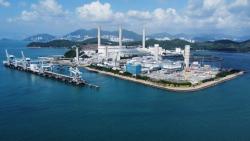
OR WAIT null SECS
© 2024 MJH Life Sciences™ and Turbomachinery Magazine. All rights reserved.
How Parsons marine steam turbines powered ships
In the second part of this series, the author talked about the story of the first little toy turbine. This article focuses on marine steam turbines and their applications.
Parsons main thrust for the steam turbine was for generating electrical power, but he also had his eyes on applying the steam turbine to drive ships of all kinds. He hit the jackpot here. There is quite a story to be told. However, it was not that easy to cash in on the take.
(Parsons steam turbine-powered Turbinia)
There were many problems to overcome such as the sudden need for maximum speed and power for war ships whereas they needed to cruise at a much lower speed for maximum efficiency. Then there developed the problem of cavitation of the screws when running at high propeller RPM. A demonstration was needed to get the Admiralty to take a look at this new prime mover. After all, it had the old reliable reciprocating steam engine to use and why look elsewhere. It was much easier to apply the steam turbine to drive merchant ships that operated at constant and most economical speeds most of the time. Besides, these people would be easier to convince as to the benefits of the steam turbine. It was only a couple of years until he formed his second company, the Parsons Marine Steam Turbines Company, located in Newcastle.
Before he regained his patent rights to his parallel flow steam turbine he started thinking about building an experimental fast speed steam turbine driven demonstration ship. In 1891 he built his first condensing turbine. It was a 2000 horse power outward flow radial turbine he made and tested in his works at Heaton. He thought that this would make a good driver for the proposed experimental ship.
He started out by making a 2-feet-long model ship and with a fishing rod and line in a small pond near his home at Ryton-on-Tynes. The model had a 2-bladed prop that was a half inch in diameter and he got 6 knots out of it. He then built a 6-feet-long model also driven with rubber bands. The resistance of the model was determined by towing it in a larger pond near the Heaton Works. Many tests were run and with this data he quite accurately determined the horse power required to drive a 100-feet-long vessel at 35 knots. This boat was to become the World famous ‘Turbinia’. It was to be of a torpedo ship design. Armed with this data he was able to form a small syndicate for the building of the real 100-feet-long boat.
The 34.5 knot Turbinia ship
The “Turbine” was built and initially powered by the before mentioned 2000 horse power outward flow steam turbine. The first run took place on November 14, 1894 with a single 30-inch two-bladed propeller running at 1730 RPM. The prop gave excessive slip of 48.8% and the ship would hardly go 20 knots. Other props were tried to no avail. A 4-bladed prop at 1600 RPM gave no better results. A torque meter showed that the steam turbine was not the trouble. It was the slippage of the prop. The Navy had recently run into this phenomenon in 1893, a year earlier, on a recip steam powered ship, the “Darling”, at 27 knots. Sir John Thornycroft and S. W. Barnaby who determined what the cause was for the first time in history named it ”Cavitation”. It was back to testing the props by Parsons to see what could be done. Cavitation was unowned to Parsons at the time. They learned the hard way.
After many tests using water tanks it was decided to:
(1) re-design the ship to have three shafts with each shaft driving three 18-inch props making a total of 9 props, with the two outer ones running at 2200 RPM and the center at 2000 and
(2) replace the steam turbine with three parallel flow turbines, with the LP turbine exhausting into a condenser in the center, the IP turbine on the left side and the HP on the right.
The sea tests on the re-designed “Turbinia” were resumed in February, 1896, a little over a year after the first tests. Speeds of over 32 knots were immediately realized and the top speed obtained was over 34.5 knots. It was now time to impress the Royal Navy. Parsons had something to show all the Navies around the world just what his steam turbine could do to drive Naval vessels at high speeds -- both small and large war machines.
What Turbinia could do
In June of 1897, at the Queen Victoria's Diamond Jubilee Fleet Review, Parsons had his chance to show the British Admiralty and the rest of the World what his little ‘Turbinia’ jewel could do. With Parsons himself running the turbines, the little ship darted in and out around all the British vessels and those of other countries at speeds of 34 to 35 knots while all that the others could muster was about 27 knots. This demonstration stunned all the Naval hierarchy in attendance.
Within two years, the British destroyers HMS “Viper” and “Cobra” were launched being driven by 12,300 horse power Parsons steam turbines at speeds of over 37 knots for the “Viper” and 36 for the “Cobra”. Many more Naval ships followed from England and many other countries as well, including the USA. Yes, he had hit the jackpot and was cashing in the chips. The first turbine passenger ships, the ‘Clyde’ and ‘King Edwards,’ were operating in 1901.
British Naval Ships
Unfortunately, both the ‘Viper’ and the ‘Cobra’ after only about a year at sea, were lost through no fault of the turbines. But in this short time period of time, before full tests and evaluations could be made, considerable operating data was obtained to be used by the British Navy to allow it to order more Parsons steam turbine powered war ships. The little ‘Turbinia’ was still ready and willing to be tested.
In the next article, the author explores the different British Naval ships and their growth spanning a decade.
Ivan G. Rice was past chairman of the South Texas Section of ASME (1974 - 75), past chairman of the ASME Gas Turbine Division (now IGTI) (1975 - 76). A Life Fellow Member of ASME and Life Member of NSPE/TSPE, he has authored many articles and ASME papers on gas turbines, inter-cooling, reheat, HRSGs, steam cooling and steam injection.
How modern day steam turbines came to be
Story of the first toy turbine



